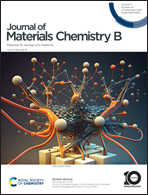A metal–organic framework-based fluorescence resonance energy transfer nanoprobe for highly selective detection of Staphylococcus Aureus†
Abstract
Survival and infection of pathogenic bacteria, such as Staphylococcus aureus (S. aureus), pose a serious threat to human health. Efficient methods for recognizing and quantifying low levels of bacteria are imperiously needed. Herein, we introduce a metal–organic framework (MOF)-based fluorescence resonance energy transfer (FRET) nanoprobe for ratiometric detection of S. aureus. The nanoprobe utilizes blue-emitting 7-hydroxycoumarin-4-acetic acid (HCAA) encapsulated inside zirconium (Zr)-based MOFs as the energy donor and green-emitting fluorescein isothiocyanate (FITC) as the energy acceptor. Especially, vancomycin (VAN) is employed as the recognition moiety to bind to the cell wall of S. aureus, leading to the disassembly of VAN-PEG-FITC from MOF HCAA@UiO-66. As the distance between the donor and acceptor increases, the donor signal correspondingly increases as the FRET signal decreases. By calculating the fluorescence intensity ratio, S. aureus can be quantified with a dynamic range of 1.05 × 103–1.05 × 107 CFU mL−1 and a detection limit of 12 CFU mL−1. Due to the unique high affinity of VAN to S. aureus, the nanoprobe shows high selectivity and sensitivity to S. aureus, even in real samples like lake water, orange juice, and saliva. The FRET-based ratiometric fluorescence bacterial detection method demonstrated in this work has a prospect in portable application and may reduce the potential threat of pathogens to human health.

- This article is part of the themed collection: Functional Framework Materials for Biomedical Applications


 Please wait while we load your content...
Please wait while we load your content...